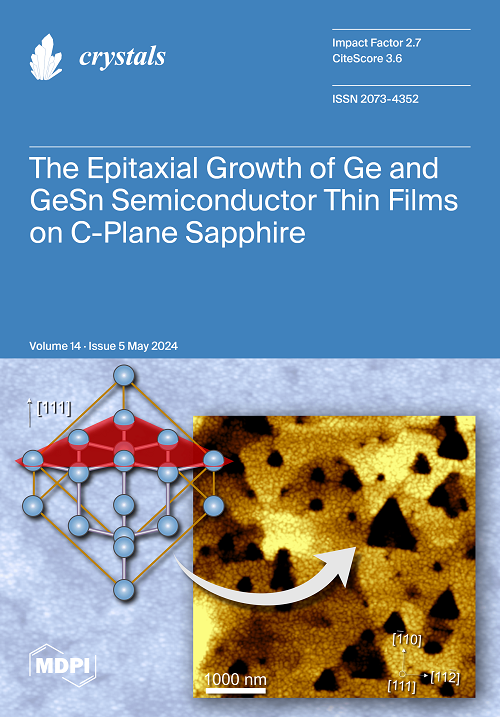The Counterion (SO42− and NO3−) Effect on Crystallographic, Quantum-Chemical, Protein-, and DNA-Binding Properties of Two Novel Copper(II)–Pyridoxal-Aminoguanidine Complexes
IF 2.4
4区 材料科学
Q2 CRYSTALLOGRAPHY
引用次数: 0
Abstract
New Cu(II) complexes with pyridoxal-aminoguanidine (PLAG) ligands and different counterions (SO42− and NO3−) were prepared and their crystal structures were solved by the X-ray crystallography. The geometries of the obtained complexes significantly depended on the counterions, leading to the square-pyramidal structure of [Cu(PLAG)NO3H2O]NO3 (complex 1) and square-planar structure of [Cu(PLAG)H2O]SO4 (complex 2). The intermolecular interactions were examined using the Hirshfeld surface analysis. The theoretical structures of these complexes were obtained by optimization at the B3LYP/6-311++G(d,p)(H,C,N,O,S)/LanL2DZ(Cu) level of theory. The Quantum Theory of Atoms in Molecules (QTAIM) was applied to assess the strength and type of the intramolecular interactions and the overall stability of the structures. The interactions between the complexes and transport proteins (human serum albumin (HSA)) and calf thymus DNA (CT-DNA) were examined by spectrofluorometric/spectrophotometric titration and molecular docking. The binding mechanism to DNA was assessed by potassium iodide quenching experiments. The importance of counterions for binding was shown by comparing the experimental and theoretical results and the examination of binding at the molecular level.反离子(SO42- 和 NO3-)对两种新型铜(II)-吡哆醛-氨基胍配合物的晶体学、量子化学、蛋白质和 DNA 结合特性的影响
本研究制备了具有吡哆醛-氨基胍(PLAG)配体和不同反离子(SO42- 和 NO3-)的新铜(II)配合物,并通过 X 射线晶体学解决了它们的晶体结构问题。所得到的配合物的几何结构在很大程度上取决于反离子,从而形成了[Cu(PLAG)NO3H2O]NO3(配合物 1)的方阵结构和[Cu(PLAG)H2O]SO4(配合物 2)的方阵结构。利用 Hirshfeld 表面分析法研究了分子间的相互作用。这些复合物的理论结构是在 B3LYP/6-311++G(d,p)(H,C,N,O,S)/LanL2DZ(Cu) 理论水平上优化得到的。原子分子量子理论(QTAIM)被用来评估分子内相互作用的强度和类型以及结构的整体稳定性。复合物与运输蛋白(人血清白蛋白(HSA))和小牛胸腺 DNA(CT-DNA)之间的相互作用通过分光荧光测定法/分光光度滴定法和分子对接法进行了检验。碘化钾淬灭实验评估了与 DNA 的结合机制。通过比较实验结果和理论结果以及分子水平的结合检查,显示了反离子对结合的重要性。
本文章由计算机程序翻译,如有差异,请以英文原文为准。
求助全文
约1分钟内获得全文
求助全文
来源期刊

Crystals
CRYSTALLOGRAPHYMATERIALS SCIENCE, MULTIDIS-MATERIALS SCIENCE, MULTIDISCIPLINARY
CiteScore
4.20
自引率
11.10%
发文量
1527
审稿时长
16.12 days
期刊介绍:
Crystals (ISSN 2073-4352) is an open access journal that covers all aspects of crystalline material research. Crystals can act as a reference, and as a publication resource, to the community. It publishes reviews, regular research articles, and short communications. Our aim is to encourage scientists to publish their experimental and theoretical results in as much detail as possible. Therefore, there is no restriction on article length. Full experimental details must be provided to enable the results to be reproduced. Crystals provides a forum for the advancement of our understanding of the nucleation, growth, processing, and characterization of crystalline materials. Their mechanical, chemical, electronic, magnetic, and optical properties, and their diverse applications, are all considered to be of importance.
 求助内容:
求助内容: 应助结果提醒方式:
应助结果提醒方式:


